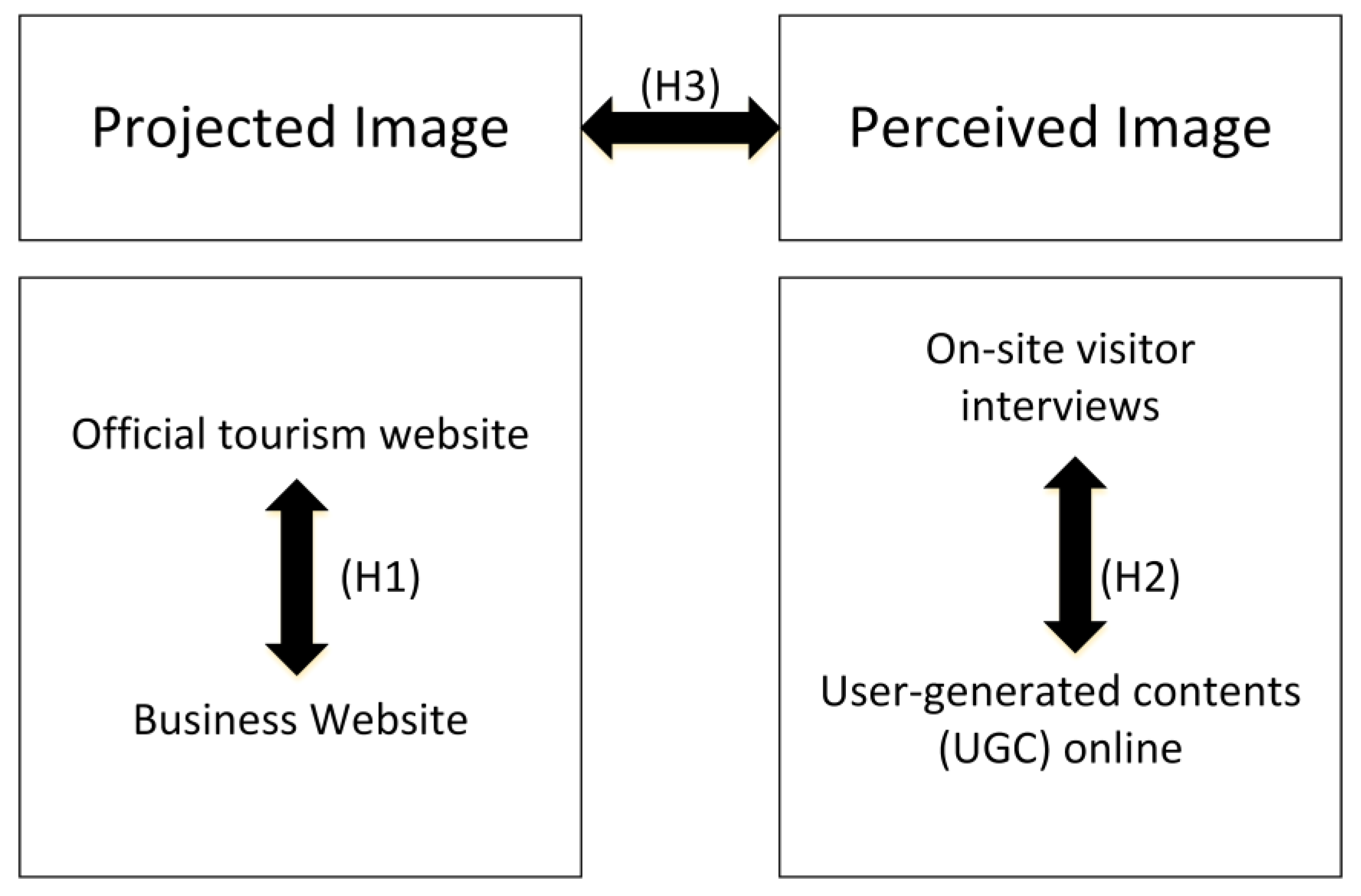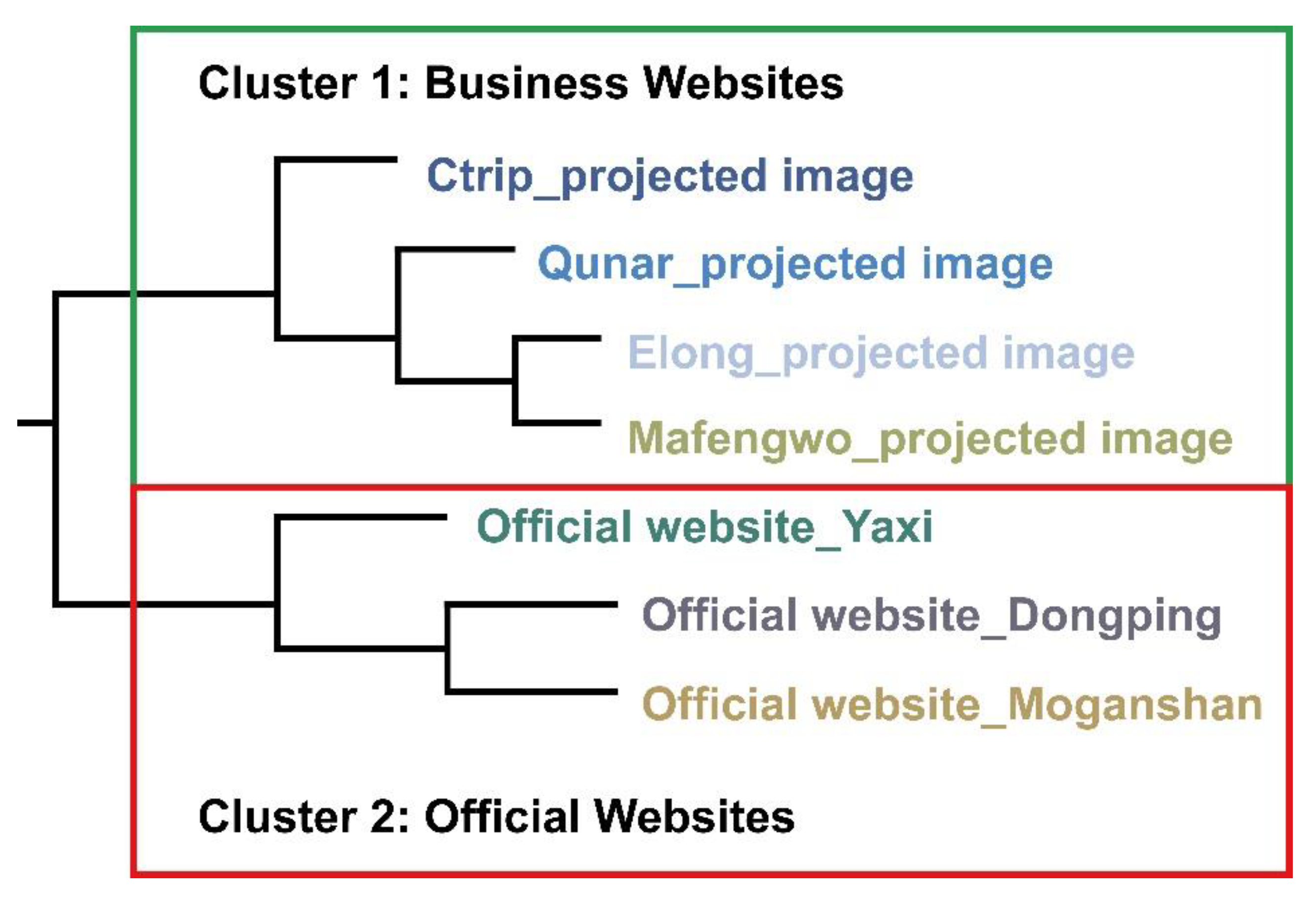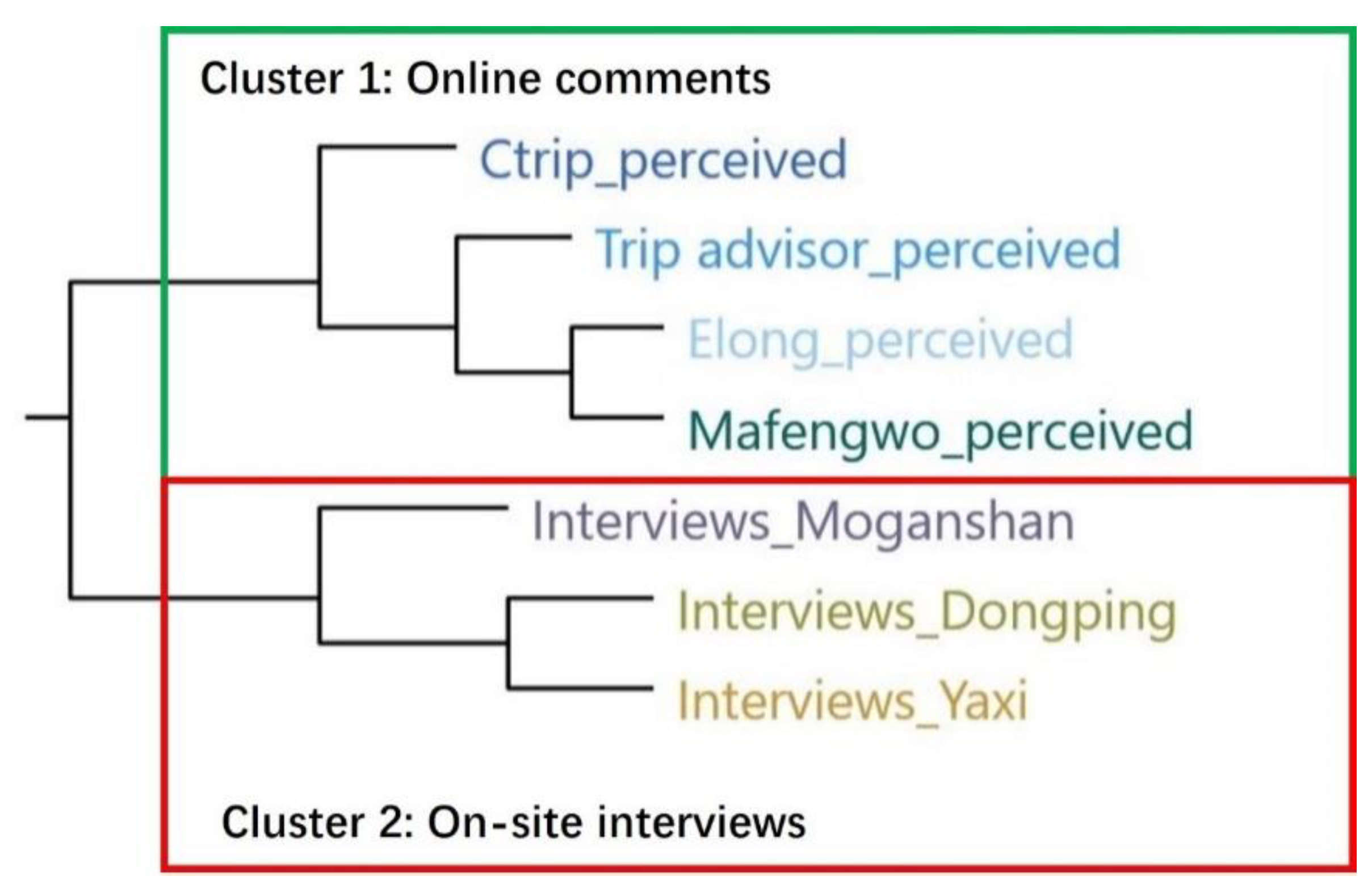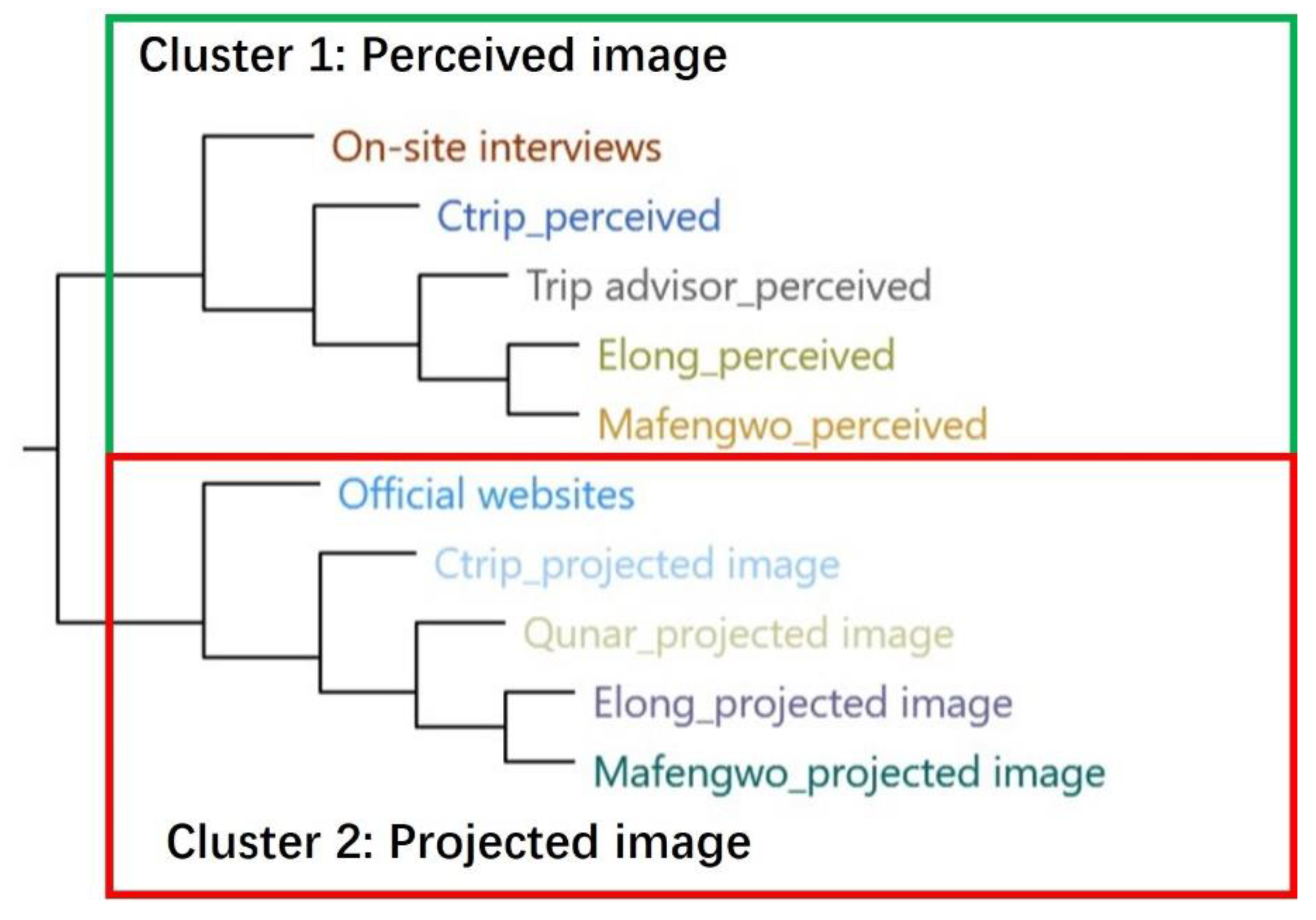4.1. Discrepancy in the Projected Image: DMO Websites versus Business Websites (Entrepreneurs) (Gap 1)
Table 3 shows that the top 10 most frequent nodes of the projected image on official websites are the geographical context, attractions, social and cultural elements, activities, biodiversity, rurality, environment quality, transportation, rural cuisine, and rural souvenir. This table demonstrates that official DMO websites exert more effort to promote the destination and to provide background information to tourists, especially regarding the top three aspects: the geographical context, attractions, and social and cultural elements. Example 1 is retrieved from a paragraph on the official website of Moganshan. It introduces the geographical context of the mountain, enriching the geological knowledge of website visitors.
Example 1. The projected image on official websites.
“Moganshan was formed in the Late Jurassic movement of the Mesozoic and, later, the Himalayan movement. This period was accompanied by strong volcanic eruptions and magmatic intrusion activities, as well as the unbalanced rise and fall of the landscape, resulting in a volcanic uplift structure dominated by volcanic rocks. The main peak is 719 meters above sea level. The mountain body is oriented from north to east. The western part is characterized by low mountain erosion and eroded tectonic features, and the eastern part is characterized by erosion-piedmont plain features.” (adopted from the Moganshan official website)
The nodes of the projected image on business websites (
Table 4) show that the top 10 most frequent nodes are attractions, the choice of accommodations, package tours, activities, the quality of accommodations, the price of accommodations, social and cultural elements, rurality, the geographical context, and transportation. From this list, we see that business websites mostly focus on promoting tourism products, such as attractions, accommodations, and package tours. Example 2 is obtained from the travel guide on Mafengwo, a popular travel website in China. The fact that it highlights the accommodations in Moganshan reflects the profit-oriented nature of entrepreneurs.
Example 2. The projected image on business websites.
“Moganshan is most famous for its homestays. Some people say that even if you miss Moganshan Mountain, you should never miss the homestays in Moganshan. They are not traditional homestays. Instead, they integrate the elements of a boutique hotel. In general, it is suggested that you stay in Moganshan for at least two or three days, and during the stay, the local homestay is an indispensable quality experience.” (adopted from Mafengwo)
Cluster analysis confirms the gap and generates two major clusters (
Figure 2), partitioning the official websites and the business websites. The dendrogram shows two main clusters, demonstrating that the business websites share more common nodes, while the official websites of DMOs show more similarities in terms of nodes. Therefore, the first hypothesis, which proposes that there is a gap between the projected image from DMOs and the projected image from tourism entrepreneurs, is accepted.
The cluster analysis shows that differences exist between the projected images on official websites and business websites. The texts on official websites provide more background information, including information on the geographical context, attractions, and social and cultural elements. From the texts, it can be inferred that DMOs aim to introduce and promote the destination. On the other hand, regarding business websites, we find that most of the information concerns attractions, accommodations, and package tours, which can directly generate revenue. This finding reflects the profit-oriented nature of business websites.
4.2. Discrepancy in the Perceived Image: UGC versus On-Site Interviews (Gap 2)
The nodes of comments on social media are presented in
Table 5. The top 10 most frequent nodes are attractions, transportation, rurality, the destination is relaxing, activities, biodiversity, the destination is pleasant, the destination is arousing, geographical context, and social and cultural elements. The social media comments include not only information about the destination but also content related to sentiment. Many of the comments report that visitors feel that the place is relaxing and pleasant (Example 3), based on which we see that the majority of the sentiment content is positive. Previous scholars have found that affective image factors exert a more powerful influence on tourists’ behavioral intentions [
71,
72]. Thus, rural tourism proponents need to focus on online marketing to highlight contents that express positive sentiments, which may attract visitors to revisit and recommend destinations to others.
Example 3. The perceived image from online comments.
“The Cittaslow is very close to Nanjing and takes more than an hour to drive to. When I went, there was a light rain. It would definitely be a nice choice to go on a sunny day. There are a lot of rape fields, and the village covers a large area. You can take a tour bus or rent a bike for excursions. I personally recommend cycling when the weather is good because it will be very relaxing! In short, it is a good destination for children and elderly people to visit.” (a comment about Yaxi town on the Ctrip website)
Regarding on-site visitors, there are both negative and positive sentiment contents (
Table 6). A large proportion (7.39%) of the comments by on-site visitors indicate that the destination is sleepy, while 1.71% of the comments show that the destination is pleasant. On-site visitors were more concerned about rurality (1.76%). The other cognitive contents in the list of the top 10 most frequent nodes are environment quality, rural cuisine, attractions, activities, accommodation quality, and choices of accommodation. Interestingly, the sentiment component is the opposite of that in the perceived image from UGC. This finding shows that the satisfaction level of on-site rural visitors is lower than that obtained from online comments (Example 4).
Example 4. The perceived image from on-site visitors.
“The environment of the Dongping Forest Park is not bad, but there are no entertainment facilities in the surrounding areas, and there are not many things to do. The homestay rural tourism conditions on Chongming Island are also not very good, and overall, it is a bit disappointing.” (comment from an on-site visitor in Dongping Town).
The cluster analysis results (
Figure 3) visualize the differences, clearly partitioning the social media contents and on-site interviews. The results demonstrate that, on the tourism demand side, there is a gap between the perceived image from on-site visitors and the perceived image from UGC. Thus, the second hypothesis is also accepted. Examples 3 and 4 show that the online comments about a destination are usually more positive and more detailed than the comments by on-site visitors.
4.3. Discrepancy between the Projected Image and Perceived Image (Gap 3)
The overall projected image of rural tourism is illustrated in
Table 7. Most of the projected image focuses on transportation, attractions, package tours, the choice of accommodations, the geographical context, social and cultural elements, activities, the quality of accommodations, rurality, and the price of accommodations. Cognitive image factors are dominant in the projected image. More descriptive words and informative content appear in the projected image from both official websites and business websites. In the list of the top 10 most frequent nodes, there are no sentiment or affective images involved.
Regarding the perceived image from both visitors online and on-site, more affective image and sentiment contents exist. The list of the top 10 most frequent nodes in
Table 8 shows that rurality is the most frequently mentioned node, which indicates that the image of rurality is a crucial part of the rural tourism destination image. In addition to the cognitive image components, the perceived image from online and on-site visitors always contains personal feelings towards a destination. Both positive and negative contents are shown, while there are more positive contents than negative contents. Three affective image factors are included in the top 10 most frequent nodes, and two of them are positive: the destination is pleasant” and “the destination is relaxing.” The negative affective image factor is “the destination is sleepy.”
The cluster analysis (
Figure 4) proves that there are differences between the overall projected image and perceived image of rural destinations in China, which shows that the third hypothesis is accepted. The contents obtained from online comments and on-site interviews contain more affective components, while the contents projected online from official websites and business websites emphasize cognitive components, such as the destination background, itinerary, transportation, and accommodations. Thus, there is a gap between the projected image from the tourism supply side and the perceived image from the tourism demand side.









